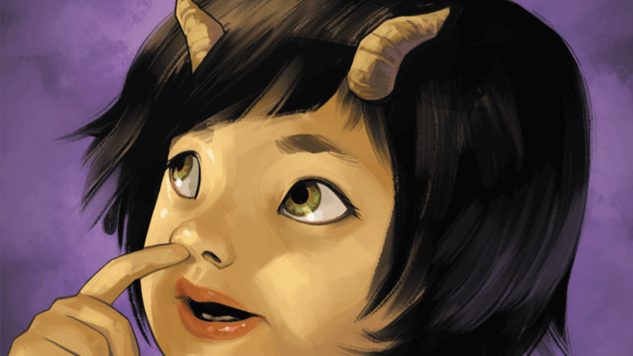
We can’t speak to any possible May flowers, but the final Wednesday in April is certainly showering us with noteworthy new comics (zing!). Readers with the patience to wait a whopping 17 issues between Saga collections—or all five of you who haven’t yet gotten hip to the modern classic—are rewarded with the second deluxe hardcover tome. Fans of pulp vigilantes get a two-for-one deal in Batman/The Shadow, and horror/sci-fi nerds are blessed with the much-ancitipated debut of James Stokoe’s Aliens: Dead Orbit. Guy Delisle and Lynda Barry keep the more “literary” crowd satisfied while Gerard Way and Nick Derington wrap up the first arc of their beyond-stellar Doom Patrol revival and an Archie bit player gets his 15 minutes of fame. April may be on the way out, but it’s giving its all before it goes.
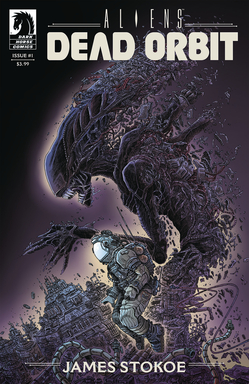 Aliens: Dead Orbit #1
Aliens: Dead Orbit #1
Writer/Artist: James Stokoe
Publisher: Dark Horse
Canadian cartoonist James Stokoe is one of the most unique and gifted talents working in monthly comics, whether on creator-owned books like Orc Stain or contributing to existing characters ranging from Godzilla to Moon Knight. Aliens: Dead Orbit is, of course, an example of the latter, and Stokoe applies his hyper-detailed linework and evocative gradient colors to terrifying claustrophobic effect, eschewing the run-and-gun nature of many expanded-universe Aliens entries in favor of the mounting tension of the original Ridley Scott film. Like the first Alien, Dead Orbit strands one engineer on a derelict vessel haunted by an acid-blooded Xenomorph. Stokoe tweaks the premise by telling the story in two chronologies: before the beast is loosed and once the crew is reduced to a sole survivor. For more on this outer-space horror, be sure to check out our interview with Stokoe. Steve Foxe
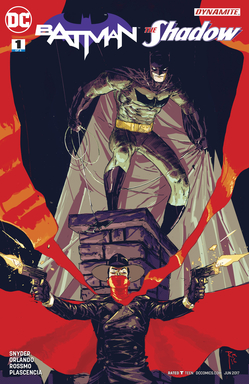 Batman/ The Shadow #1
Batman/ The Shadow #1
Writers: Steve Orlando & Scott Snyder
Artist: Riley Rossmo
Publisher: DC Comics/Dynamite
The name Lamont Cranston will be familiar to pulp fans, but it’s no Bruce Wayne in terms of pop-culture recognition. For decades, The Shadow solved mysteries in print and on the air waves, starring in his own series of novels and radio dramas that earned him quite an audience, but that early popularity in the ‘30s and ‘40s never quite translated to long-term success in comics, despite a daily news strip and a run at Archie Comics in the late ‘60s. Steve Orlando and Scott Snyder are bringing the vigilante back to primetime with artist Riley Rossmo in a new mystery that pits the Shadow against Gotham’s own masked detective. This isn’t the first time the Shadow and Batman have interacted, but with Cranston (at least initially) placed in a more sinister role, and the promise of more than just a fleeting cameo appearance, Batman/The Shadow has the potential to stand out among current Gotham offerings. Rossmo proved with Constantine that he knows his way around an atmospheric, gritty setting, and with established DC scribes Snyder and Orlando teaming up, readers will want to grab this book so that they too can know what evils lurk in the hearts of men. Caitlin Rosberg
 Big Moose #1
Big Moose #1
Writers: Sean Ryan, Ryan Cady, Gorf
Artists: Thomas Pitilli, Cory Smith, Ryan Jampole, Matt Herms, Glenn Whitmore, Kelly Fitzpatrick, Jack Morelli
Publisher: Archie Comics
Moose Mason is one of the few Archie characters who hasn’t been given a spotlight of his own since the Mark Waid and Fiona Staples-led reboot of the Archie universe in 2015. Jughead, Betty and Veronica, and even Reggie have all had their turns in the spotlight, so it’s high time Riverdale’s best athlete gets some, too. Moose would be easy to write off as a dull character without enough definition to support his own book, but as the show Riverdale has proven with just a few scant minutes of screen time, there are layers to the gentle giant. At double the length of a standard monthly title, there’s a lot of space to delve into the story elements that have highlighted Moose’s potential before. This one-shot includes three separate stories from three distinct teams, the only consistent element being Jack Morelli’s lettering, which could pose an issue with an ongoing book, but shouldn’t for a one-shot. With Gorf, of Batman: No Man’s Land and Birds of Prey fame, on the roster, at least one of those stories should be an interesting ride. Caitlin Rosberg
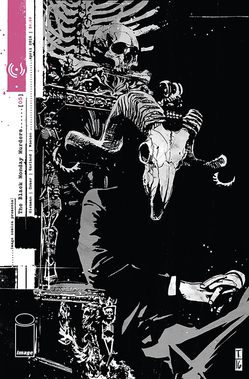 Black Monday Murders #5
Black Monday Murders #5
Writer: Jonathan Hickman
Artist: Tomm Coker
Publisher: Image Comics
The wait for the next arc of Jonathan Hickman and Tomm Coker’s atmospheric, eldritch murder mystery ends with Black Monday Murders #5. Hickman himself has evoked Harry Potter to describe the world that they’ve created in this comic, a sort of “what if” universe where the Hogwarts houses are populated by truly terrible adults who use dark magic to manipulate and control the economy. It’s Lovecraft meets The Wolf of Wall Street, taking the idea that greed is good and extending it to gods and monsters. Coker’s dark, detailed art is what makes this book come alive, with swaths of shadow breaking up space and turning faces into masks of pain and horror. With a new arc starting in this issue, it’s the perfect place to jump on, though the previous issues are worth running down to get the backstory. The previous arc has already been collected in a trade paperback volume, along with graphs and meaty backmatter and notes, written like minutes for the most terrifying board meetings in the world. Caitlin Rosberg
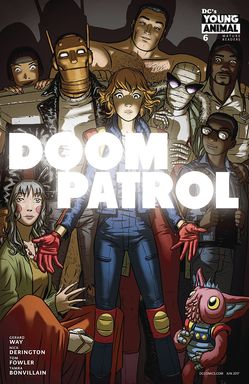 Doom Patrol #6
Doom Patrol #6
Writer: Gerard Way
Artist: Nick Derington
Publisher: DC Comics/Young Animal
Doom Patrol may be the most fun, least self-conscious comic book since…Doom Patrol. Gerard Way and Nick Derington’s innovative love letter to the post-modern comics of former Patrol scribe Grant Morrison and editor Karen Berger’s Vertigo imprint is as relentlessly imaginative as any of the works that inspired it. As Way notes in his latest comics sampler, “You can do anything in comics!” and this comic is proof perfect of that statement. The first arc concludes with this issue, featuring ambulance driver Casey Brinke as she takes her mission from a city to multiple timelines and universes, aided by robots, ‘20s strongmen and humans warped into alien torrents of energy. Derington reliably channels Way’s concussive jet stream of ideas into stylized, clear visuals, buoyed by Tamra Bonvillain’s cheerful colors. Form is function in Doom Patrol: in the face of overwhelming existential dread, hope only dies when heroes stop hoping, and these avatar of bizarre, brilliant optimism have never been more relevant. Sean Edgar
 Hostage
Hostage
Writer/Artist: Guy Delisle
Publisher: Drawn & Quarterly
Guy Delisle’s library has largely stemmed from the cartoonist’s international ventures through exotic geographies including Jerusalem, Burma, North Korea and China. His intimate, stylized lines escorted readers through the areas via travelogues, volleying exciting bits on culture and history with each new panel sequence. Hostage is a jarring departure in both tone and approach. The 436-page doorstop relays the trials of Christophe Andre, a Doctors without Borders employee who was tossed into solitary confinement for 100 days while working in North Caucasus. Instead of the breakneck parade of culture clash and architecture, Delisle now traps readers inside four grim walls alongside his protagonist for a very, very, very long time. This book is an exercise in brutal empathy, a meditation on the sparsely worded monotony and terrifying ambiguity of human captivity. The result is simply intense, a crystalline example of what sequential storytelling is capable of communicating. Sean Edgar
 ‘Nam Wolf #1
‘Nam Wolf #1
Writer: Fabian Rangel, Jr.
Artist: Logan Faerber
Publisher: Albatross Funnybooks
Sometimes it’s just not necessary to over-think a book’s appeal. ‘Nam Wolf is about werewolves at war, as rendered in Logan Faerber’s singular, off-kilter style. What more do you really want? Writer Fabian Rangel, Jr. has a knack for pairing with idiosyncratic artists and getting out of their way (see also: Space Riders with Alexis Ziritt) and ‘Nam Wolf seems no different, based on the early-concept ashcan that made the convention rounds before Eric Powell’s Albatross Funnybooks picked up the story for distribution. Faerber’s lycanthropic soldiers are all toothy angles, casting shadows straight out of “Little Red Riding Hood”—if the Big Bad Wolf shot hot lead. Sometimes the title tells you everything you need to know to get hyped about a book. Steve Foxe
 One! Hundred! Demons!
One! Hundred! Demons!
Writer/Artist: Lynda Barry
Publisher: Drawn and Quarterly
Originally published in 2005, this is a new rerelease of Lynda Barry’s semi-autobiographical graphic novel-slash-artistic exercise. A veteran creator with graphic novels and a long-running comic strip under her belt, Barry uses an exercise called “One Hundred Demons” to exorcise herself of bad memories and emotions. The scenes she draws are personal and intimate, but universal in their overarching themes: embarrassment after mockery, heartbreak, the ways that people change and shutter themselves to avoid ridicule. Barry has a sharp wit and the type of honesty that is brutal without being cruel, which is a fine line to tread. Her style is not quite cartoony, but it doesn’t sacrifice evoking emotion for adding detail. Many of the drawings look like they are drawn on lined paper and bordered in doodles of beasts and animals, giving the impression that she is sharing her own journal, something intimate but also achievable. The panels pack an overdose of words, skewing closer to the style of zines and underground comics than some readers may be familiar with, but Barry’s observations and humor are well worth the extra reading. Caitlin Rosberg
 Saga Book Two Deluxe HC
Saga Book Two Deluxe HC
Writer: Brian K. Vaughan
Artist: Fiona Staples
Publisher: Image Comics
What more hyperbole do you need from Paste to endorse genre fiction’s greatest modern feat? Writer Brian K. Vaughan and artist Fiona Staples have proven themselves as machines of dependable narrative genius, relaying the story of an inter-species family on the run from two warring space empires—their hybrid toddler caught in the middle. For readers who prefer to wait for the binge read, Image Comics offers these paper anchors that house 17 issues, the second volume of which releases this week. Bundling chapters #19-36, the collection shows parents Alana and Marko struggle with growing relationship fissures and drug addiction before facing off against interstellar extremists. Overall, the tale takes a far more challenging look at what families face instead of falling back on the escapist romanticism that arboreal space ships and bipedal seal children might fall into. The work further confirms Staples as an illustrator who can give form to any idea through her lush digital inks, no matter how otherworldly. Just look at her space water-bears if you disagree. Sean Edgar
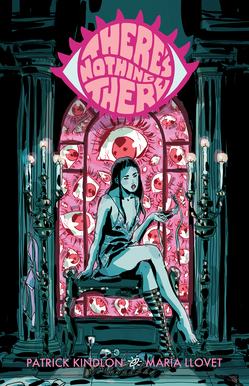 There’s Nothing There #1
There’s Nothing There #1
Writer: Patrick Kindlon
Artist: Maria Llovet
Publisher: Black Mask
You’d be forgiven for not recognizing Patrick Kindlon’s name. The Drug Church and Self Defense Family singer is the co-writer behind the Black Mask breakout We Can Never Go Home, but admits in the backmatter to There’s Nothing There #1 that he let his writing partner Matthew Rosenberg handle most of that title’s reader-facing PR. Disdain for marketing aside, Kindlon presents an assured voice in his debut solo title, tapping into occult conspiracy theories, Polanski-esque psychological unraveling and the perils of uber-fame in this horror mini-series about a starlet who begins seeing spooks after an ominous, Eyes Wide Shut-style orgy. Kindlon shares the spotlight with artist Maria Llovet, who makes her American debut rendering pleasure and haunting apparitions with equal skill. For readers who appreciate horror with more tension than gore, There’s Nothing There heralds two major new talents. Steve Foxe